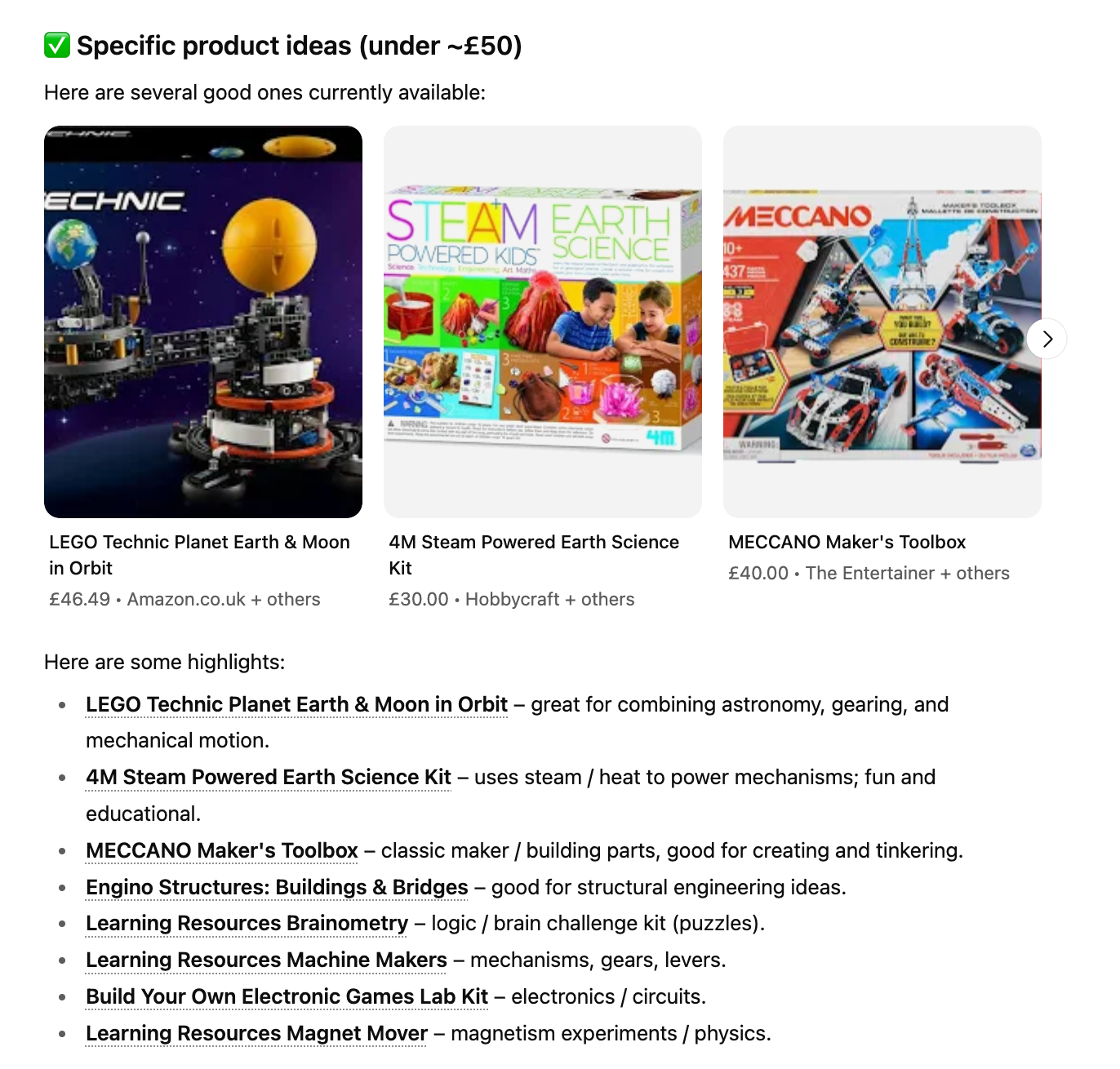
LoyaltyLion Integration: Reward Your Customers & Boost Your Sales

Shoppers are no longer scanning search results and clicking through multiple sites to make a choice. They now expect AI to do the work for them - weighing up alternatives, filtering by budget or values, and even suggesting gifts.
And the journey is getting even shorter. With OpenAI’s new Instant Checkout inside ChatGPT, shoppers may not even need to leave the platform to complete a purchase - discovery and transaction are collapsing into a single step.
It’s a behaviour shift at scale.
Over half of consumers say they’ve already moved away from traditional search, with 58% preferring generative AI for product and service recommendations.
This leap shows just how quickly habits are changing. And why every eCommerce brand needs to grasp what this means for visibility and growth today.
This article sets the stage by exploring how generative AI is reshaping product discovery. If you want to see how review data drives GEO visibility, start with How to Rank in AI Search Results. And if you’re preparing for ChatGPT Shopping specifically, dive into Your ChatGPT Shopping Strategy.
Generative AI is technology that learns from vast amounts of data and produces new content when you ask it a question.
It’s powered by large language models (LLMs) - advanced systems trained on text from across the internet. LLMs use natural language processing (NLP) to understand what a user is really asking, not just the keywords they type.
For example, imagine you type: “best way to plan a healthy lunch on a budget.”
A traditional search engine would break this down into separate keywords like “healthy,” “lunch,” and “budget.”
The results might include diet blogs, recipe sites, or money-saving tips - leaving you to piece everything together.
Generative AI understands the context of your question: you’re looking for practical meal ideas that are nutritious and affordable.
Instead of scattered links, it produces a clear, tailored answer, such as a weekly meal plan with recipes and cost estimates.
When applied to product search, the same process happens. AI interprets the full context of what shoppers want and delivers a direct, conversational answer.
This moves the experience beyond simple keyword matching and into context-driven discovery.
Generative AI creates answers, not links. It goes beyond keywords to understand intent, and deliver contextual, conversational answers.
With generative AI, shoppers no longer search and compare across websites.
They get ready-made answers in the result itself, delivered by platforms like Google AI Overviews, ChatGPT Shopping, Perplexity, and Microsoft Copilot.
For example, instead of typing “best affordable hiking backpack” into Google and scrolling through page after page of links, a shopper can now ask “best lightweight hiking pack under £120 for rainy weekends” and instantly see a curated list of backpacks, complete with specs and snippets of customer reviews.

This means shoppers get:
To deliver this experience, generative AI pulls together multiple data points. This includes product facts (like weight, size, and price), review content (for example, “kept my kit dry in heavy rain”), and trusted sources it can cite.
So, for shoppers to be able to find you, your product data and reviews must clearly show how your products meet intent. If they don’t, AI won’t surface you in the shortlist.
Generative AI has flipped shopping on its head. Instead of browsing links, shoppers now get instant shortlists and comparisons in the result itself.
Shoppers are already folding AI into their buying journey. Here’s what that looks like in practice:
Shoppers often turn to AI to do quick, head-to-head comparisons that would usually take multiple tabs and plenty of scrolling.
Prompt example: “Dyson V12 or Shark Stratos for pet hair under £400?”
What AI looks for: Clear product specifications (suction power, battery life, noise levels) and review content that highlights key differences.
What AI delivers: A direct comparison in one place, showing how each model stacks up and which is the better fit.

Many shoppers use AI to describe their needs and budget, expecting tailored recommendations in return.
Prompt example: “Running shoes for wide feet under £120 for marathon training.”
What AI looks for: Structured attributes such as fit, weight, cushioning, and reviews from customers with similar needs.
What AI delivers: A shortlist of shoes that match the shopper’s profile, with review highlights that confirm comfort and performance.
Ethical and health-driven shopping prompts are common, with consumers asking AI to filter by values or sensitivities.
Prompt example: “Mineral SPF for sensitive skin, fragrance-free, under £30.”
What AI looks for: Ingredient lists, certifications, and reviews mentioning suitability for sensitive skin or value-driven choices.
What AI delivers: Products filtered to match the values stated, validated with feedback about gentleness and effectiveness.

Shoppers want certainty that what they buy will fit their body, home, or existing setup.
Prompt example: “Desk for a 110 cm space” or “wide-fit trail shoes.”
What AI looks for: Consistent dimensions, sizing charts, and reviews confirming fit or compatibility.
What AI delivers: Confident matches, with shopper-friendly explanations that reassure the product will work in their specific context.
AI is becoming a creative assistant for shoppers who want personalized gift inspiration.
Prompt example: “Gift for a 10-year-old who loves STEM under £50.”
What AI looks for: Product descriptions and reviews that mention gifting occasions, recipient suitability, or positive experiences as gifts.
What AI delivers: A curated list of age-appropriate, interest-based gift ideas with simple reasons for each pick.

Shoppers now expect AI to compare, filter, and recommend products for them before they ever reach your site.
In the past, you could influence discovery with SEO, ad spend, and optimised feeds. Success meant showing up in the results and competing for clicks.
With generative AI, that dynamic has changed. Shoppers are no longer choosing which links to click - they’re choosing from the shortlist that AI has already created for them.
If you’re not in that shortlist, you’re not even in the running.
The real shift is that AI doesn’t just look at keywords. It tries to understand shopper intent: what problem someone is solving, what features matter most, and what values guide their choice.
Discovery is no longer about being present on a results page. It’s about being seen as the right answer to a specific question.
That requires a new way of thinking.
Instead of asking “how do I rank higher?” brands now need to ask “how do I make sure AI sees my products as the best match for intent?”
Generative AI forces brands to optimize differently - not for clicks, but for inclusion.
Generative engine optimization (GEO) is how you stay visible in AI search.
Instead of chasing rankings like in traditional SEO, GEO is about making sure AI can clearly understand and trust your products when it builds its shortlists.
To give your products the best chance of inclusion, make sure you have:
Without these signals, AI won’t view your products as a match - and they’ll be invisible in the shortlist.
In AI search, your products are only visible if your data and reviews make them easy to understand and trust.
Shoppers no longer click through endless results. They turn to platforms like Google AI Overviews and ChatGPT Shopping for instant shortlists.
Your visibility depends on how clearly your product data and customer proof can be read and trusted by these systems.
Of all the signals AI engines use, reviews are the most powerful.
They don’t just influence people. They provide machines with the structured, detailed content needed to match your products to shopper intent.
At REVIEWS.io, we make it easy to collect the kind of rich, detailed, and structured reviews that AI platforms look for.
By capturing context like fit, use case, and results, we help ensure your products are matched to shopper intent and surfaced where it matters most.
Generative AI has changed the rules of discovery. Are your reviews ready to keep your brand in the shortlist?
Book a demo today and see how smarter review data can power your visibility in AI search.
Generative AI changes shopping by replacing long lists of links with ready-made shortlists and comparisons. Shoppers get answers instantly, and your visibility now depends on how clearly your products are represented in AI platforms.
When a shopper asks a question - like “best running shoes for wide feet under £120” - generative AI interprets the intent. It then combines product facts, reviews, and trusted sources to generate a tailored shortlist with pros, cons, and buying links.
Google AI Overviews, ChatGPT Shopping, Perplexity, and Microsoft Copilot are popular. These tools provide product recommendations, comparisons, and even gift ideas directly in the search experience.
Make sure your product and review data is clear, structured and detailed. These are the signals AI engines rely on to match products to shopper intent.



